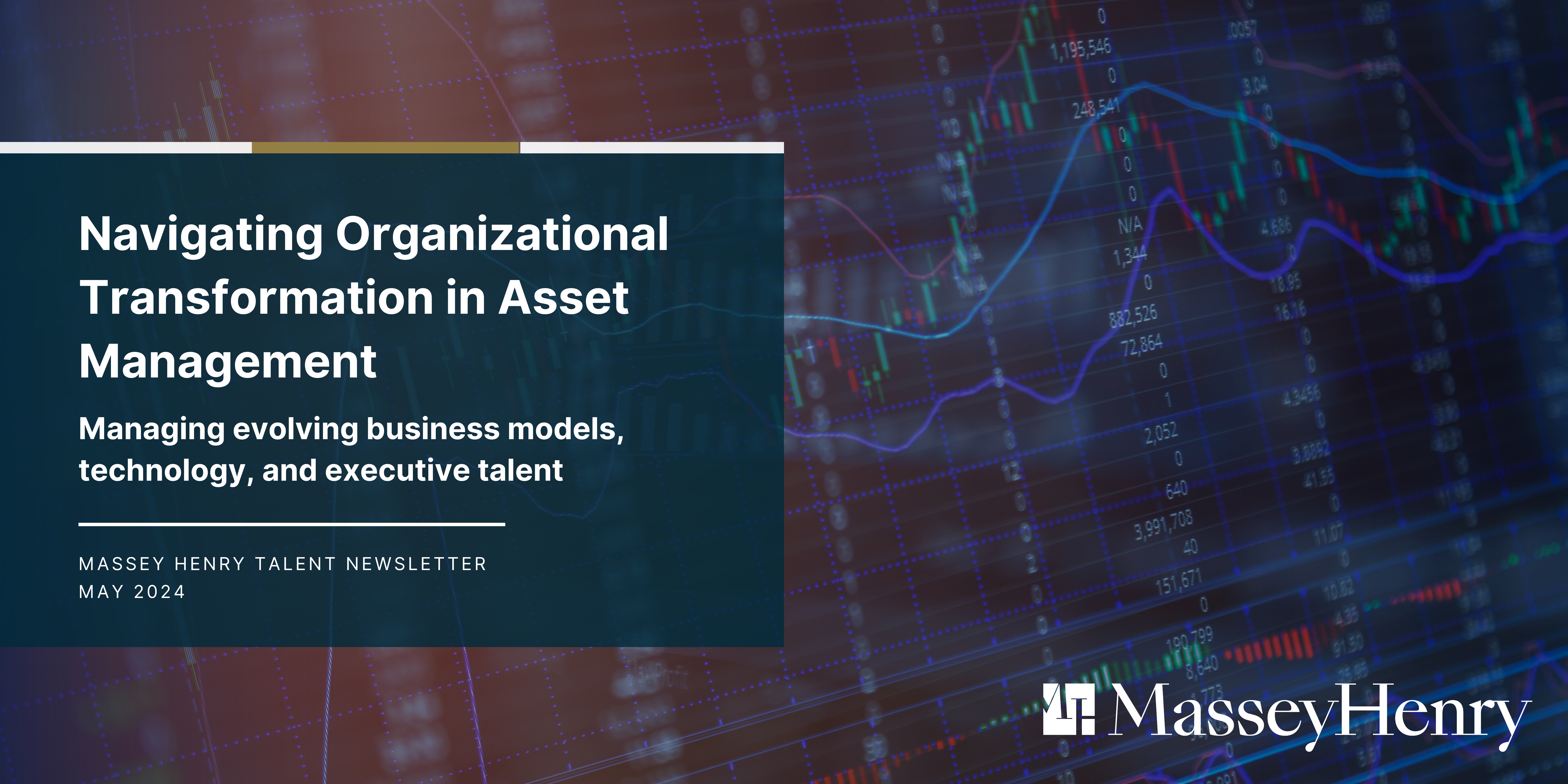
Introduction
The asset management industry is undergoing significant transformation.
The widespread adoption of digital technology, the return of interest rates to historical norms, and profound shifts in retail investor attitudes and preferences all actively drive this change.
As a result of these evolutions, the types of investments offered to clients, as well as business models, product offerings and, most significantly, investment industry executive talent requirements, are rapidly transforming to accommodate this evolution in the industry.
- Challenges and opportunities offered by the changing investment landscape
- Talent implications for organizations
- Strategies for managing significant organizational changes
From the integration of cutting-edge technology tools and the ever-increasing importance of data and insights, to emerging AI applications paired with evolving client demands, the ongoing transformations within wealth and asset management carry profound implications. From my own industry experience, and reflected in my experiences with Massey Henry, it is clear that organizations will need to enhance the assessment and development of talent competencies, with a new challenge placed on internal development to navigate these dynamic changes.
Our latest report examines the challenges and opportunities offered by the changing asset management industry and its implications for talent management.

Challenges and Opportunities
While the shifting landscape offers promising opportunities, it also presents challenges for the industry, including:
- Dealing with growing technological dependency
- Achieving scale
- Managing investors’ shifting expectations
- Democratizing asset class access
- Navigating a dynamic and volatile economic and geopolitical environment
Several meaningful market opportunities, however, are becoming available to asset managers and the wider investment industry.
Considering these market conditions, adapting talent requirements, and developing new practices for sourcing and training employees to account for this forthcoming change will be critical.
The Changing Landscape for Investors
The investment industry will increasingly integrate technology, emphasizing digital communication and personalization to the retail investment community while delivering investment solutions across various asset classes. Public equity managers primarily focused on mutual funds and ETFs, are expected to face ongoing asset outflows in the face of fee and return performance provided by passive investment strategies.
In turn, private market investment managers face fundraising and exit pressures due to inflation and lower economic growth expectations. Similar to public equity managers, alternative asset managers must address capital outflows to safely yield investments in fixed-income vehicles in the near term.
Transformation or Consolidation
For many firms in the investment industry, the pressures of the changing marketplace, talent scarcity, new product offerings, and operational cost increases, will exceed their capacity to respond. Under such circumstances, leadership teams must consider whether talent and technology gaps can be mitigated through acquisitions or mergers, while other organizations may opt to divest their business in whole or in-part.
The rise in business consolidations in the property and causality and asset management industries, as well as amongst industry and independent brokerages, suggests this trend will continue.
Talent and Technology Adaptation
The investment industry must adapt its product offerings, operations, and business strategies to effectively leverage market forces and inter-generational asset flows. Talent and technology will play central roles in successfully adapting to these new realities.
Talent and technology enablement are more closely linked than ever. All financial industry participants will require enhanced integration between three vital functional areas:
- Information Technology (IT)
- Human Resources (HR)
- Business Operations
Talent Implications
At this stage, there is no one-size-fits-all solution to tackling the complex and dynamic factors impacting the investment industry. It is essential for organizations to evaluate their competencies and experience profiles within the rapidly changing landscape of business models and technology. A collaborative competency assessment and gap analysis conducted with HR, IT, and investment managers will enable organizations to prepare for changes to their talent profiles and organization-wide technology usage.
How can organizations manage these changes?
In many respects, it is a defining moment for the investment industry. To successfully manage the pace of change, leadership teams must revisit the traditional analytical framework – People, Process, and Technology. This strategy requires going back to the basics to determine what talent is required and how talent should be sourced, compensated, and retrained. Leadership teams should seek to define the talent strategy within their organization through a structured process:
1) Engage IT, portfolio managers, and operations leaders
2) Determine and prioritize gaps
3) Identify internal competencies and crucial roles
4) Prioritize initiatives to support internal roles
5) Clarify and communicate the importance of collaborative work
Looking Ahead
What can we expect?
Given the significance of the changes within the investment industry, it is imperative to prioritize transformation initiatives, and closely monitor their progress.
Considering it is unlikely that the competitive landscape or regulatory environment will remain constant, plans for integrating talent, processes, and technology, must be strategically built, tactfully executed, and continuously adjusted for a persistently evolving marketplace.
À propos de Massey Henry
Executive Search, Coaching, Assessment, and Advisory Services

Michael Henry
Managing Partner, Massey Henry

John Sanders
Senior Partner, Board & CEO Services

Charlotte Berry
Partner

Alex Bunyan
Partner & Head, Leadership Practice
